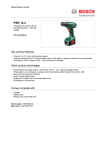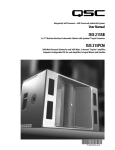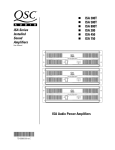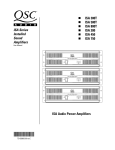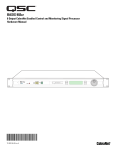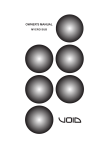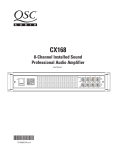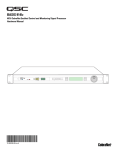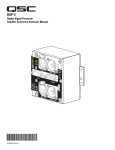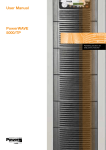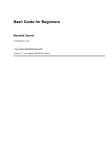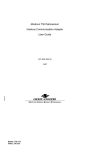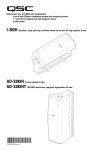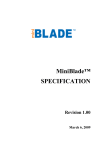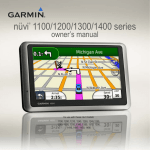Download User Manual
Transcript
PowerLight 6.0 II User Manual *TD-000108-00* TD-000108-00 rev.A PowerLight Series TM 1 IMPORTANT SAFETY INSTRUCTIONS & EXPLANATION OF SYMBOLS 1- Read these instructions. 2- Keep these instructions. 3- Heed all warnings. 4- Follow all instructions. 5- Do not use this apparatus near water. 6- Clean only with a dry cloth. 7- Do not block any ventilation openings. Install in accordance with QSC Audio Product’s instructions. 8- Do not install near any heat sources such as radiators, heat registers, stoves, or other apparatus (including amplifiers) that produce heat. 9- Do not defeat the safety purpose of the polarized or grounding-type plug. A polarized plug has two blades with one blade wider than the other. A grounding-type plug has two blades and a third grounding prong. The wide blade or the third prong is provided for your safety. If the provided plug does not fit your outlet, consult an electrician for the replacement of the obsolete outlet. 10- Protect the power cord from being walked on or pinched, particularly at plugs, convenience receptacles, and the point where they exit the apparatus. 11- Only use attachments/accessories from QSC Audio Products, Inc. 12- Use only with carts, stands, tripods, brackets, interconnecting cables, or software specified by QSC Audio Products. When moving or transporting using a cart, use caution to avoid injury from tip-over. 13- Unplug the apparatus during lightning storms or when unused for long periods of time. 14- Refer all servicing to qualified personnel. Servicing is required when the apparatus has been damaged in any way, such as power supply cord or plug is damaged, liquid has been spilled or objects have fallen into the apparatus, the apparatus has been exposed to rain or moisture, does not operate normally, or has been dropped. 15- When installing equipment into a rack, distribute the units evenly. Otherwise, hazardous conditions may be created by an uneven weight distribution. 16- Connect the unit only to a properly rated supply circuit. 17- Reliable earthing (grounding) of rack-mounted equipment should be maintained. 18- Maximum operating ambient temperature is 50°C. The lightning flash with arrowhead symbol within an equilateral triangle is intended to alert the user to the presence of uninsulated “dangerous” voltage within the product’s enclosure that may be of sufficient magnitude to constitute a risk of electric shock to humans. The exclamation point within an equilateral triangle is intended to alert the user to the presence of important operating and maintenance (servicing) instructions in this manual. CAUTION RISK OF ELECTRIC SHOCK DO NOT OPEN CAUTION: To reduce the risk of electric shock, do not remove the cover. No user-serviceable parts inside. Refer servicing to qualified service personnel. WARNING: To prevent fire or electric shock, do not expose this equipment to rain or moisture. The PL6.0 II has a serial number located on its side panel, next to the AC cord entry. It looks like the example, right. Please write the serial number down and keep for your records. Retain your sales receipt; it is your proof of purchase. Model: PowerLight 6.0 II Serial Number: ________________________ Date of Purchase: ______________________ Purchased From: _______________________ © Copyright 2002, QSC Audio Products, Inc. QSC® is a registered trademark of QSC Audio Products, Inc. “QSC” and the QSC logo are registered with the U.S. Patent and Trademark Office Combo is a registered trademark of Neutrik Inc., Lakewood, NJ . Speakon™ is a registered trademark of Neutrik Inc., Lakewood, NJ 2 TABLE OF CONTENTS INTRODUCTION Overview...........................................................................................4 Illustrations.............................................................................5 UNPACKING Unpacking and Inspection..................................................................................6 What is Included.............................................................................................6 SETUP Rack Mounting.................................................................................................................6 Cooling Requirements.................................................................................................8 AC Power Requirements..............................................................................9 Operating Mode Selection............................................................................10 CONNECTIONS Inputs...........................................................................................................12 DataPort....................................................................................14 Power Supply Remote Control....................................................................16 Outputs: Binding Posts...............................................................................17 Outputs: Speakons™.....................................................................................18 USE Power Switch...........................................................................................19 Power, Standby and Protect LED indicators.............................................19 Gain Controls.............................................................................................20 Signal, -20 dB, -10 dB, and Clip LED indicators........................................................20 Clip Limiters..................................................................................................21 TROUBLESHOOTING...................................................................................22 SPECIFICATIONS............................................................................................................24 APPENDIX DataPort Pinout..............................................................................................25 QSC PowerWave Technology Overview...........................................................26 WARRANTY INFORMATION .............................................................................................27 HOW TO CONTACT QSC AUDIO PRODUCTS .........................................................27 3 INTRODUCTION- General Overview Thank you and congratulations on your purchase of the QSC PowerLight 6.0 II professional power amplifier. This product represents the state-ofthe-art in power amplification systems for professional touring, permanent installations, and other SR (sound reinforcement) applications requiring high levels of sustained power, extraordinary audio performance, reduced weight, and road-proven reliability. To get the most from your investment, we encourage you to review this manual carefully. Part of the advanced technology PowerLight family of amplifiers, the PowerLight 6.0 II benefits from QSC’s exclusive PowerWave switching technology, its DataPort for remote computer control, and an enhanced design that provides greater airflow through the chassis— facilitating cooler, more efficient operation. QSC PowerWave Technology QSC’s PowerWave switching power supply technology provides ample current to the audio power circuitry by charging the supply rails 180,000 times per second through an ultra-low impedance circuit. This high-efficiency design What’s the difference between the “new” PL6.0 II and the “old” PL6.0? The chart, right, compares the two. Output power and AC current consumption are the specifications that have changed slightly. Output power is 0.9dB at 8 ohms, and -1.04dB at 4 ohms. 2 ohms power remains unchanged. AC current draw variations are a result of power factor correction removal and power supply topology changes. These changes improve reliability of the amplifier under the most demanding output conditions. 4 cuts waste heat and boosts reliability while delivering the added benefits of tighter bass and transparent highs for a more musical sound. The PowerLight 6.0 II utilizes an enhanced, second-generation power supply design. This new design reduces both EMI (electromagnetic interference) and the overall weight of the unit—enabling far greater placement options when positioning equipment. In the unlikely event your unit ever requires service, the new power supply design offers several additional benefits—including greater ease of service, resulting in reduced labor time and lower replacement costs. Remote Computer Control The PowerLight 6.0 II also incorporates QSC’s unique DataPort for remote computer control. Using QSControl, QSC’s network audio system, you can monitor and control hundreds of amplifiers simultaneously, as well as perform a wide range of advanced functions—including event logging, checking the thermal status of the amplifier, plus real-time monitoring of loudspeaker opens and shorts. INTRODUCTION- Illustrations FRONT PANEL 1- Power switch 2- Power, Standby, and Protect LEDs 3- Cooling air exhaust vents 4- Gain controls 5- Signal, -20 dB, -10 dB, and Clip LEDs REAR PANEL 1- Cooling air inlet vents 2- Domestic (North America) fixed AC power cord entry 2A- Export IEC-style detachable power cord entry 3- Mode switch (Bridge/Stereo/Parallel) 4- Input connectors (“combo” XLR/TRS and terminal blocks) 5- QSC DataPort Connector (interfaces with QSC accessories) 6- Remote power supply control 7- Output connectors 8- Operating voltage and serial number tag location (side of unit) 5 UNPACKING Unpacking and Inspection The PL6.0 II is highly durable and is carefully packaged. We recommend you inspect the unit carefully after removing it from the packaging, as occasionally there may be damage due to some unfortunate incident during shipment. Report any damage to the shipping carrier. We recommend saving the carton and packing material. It is always a good idea to keep the packaging in case the unit must be shipped back to your dealer, distributor, or service center. Also note: some freight companies consider damage claims without the original packing materials invalid. The QSC shipping box should contain: 1- the PL6.0 II amplifier 2- this Owner’s Manual 3- accessory packet containing: -rear rack ear mounting kit -terminal-block connectors for inputs and remote power supply control -four adhesive feet SETUP- Rack Mounting Supporting the Front of the Amplifier Rack mounting of the amplifier is optional. The PL6.0 II is designed to fit a normal 19-inch width equipment rack. Secure the front rack ears using four machine screws with washers, as shown below. Verify operating voltage printed on the serial number plate; it is located on the side panel by the AC cord entry. Once the amplifier is mounted, it may be difficult to read this information (see p.9). CAUTION! To minimize the risk of injury, we recommend an assistant help support the amplifier during rack installation. When installing equipment into a rack, distribute the units evenly. Otherwise, hazardous conditions may be created by an uneven weight distribution. 6 SETUP- Rack Mounting Supporting the Rear of the Amplifier For mobile and touring use, it is extremely important to support the rear of the amplifier. The chassis and rack can be damaged if the amplifier is not properly supported. Unless the amplifier is being installed in its final, fixed location, QSC strongly recommends supporting the rear of the amplifier. Rear rack ears, required hardware, and a separate instruction sheet are included with your amplifier. The Specifications section includes helpful dimensions for determining rear support locations. Attaching Rear Rack Ears Method 1 The amplifier is first installed from the front of the rack and secured to the front rack rails. The rear ears are then secured to the amplifier using two machine screws. The ears are secured to the rails using regular rack hardware. Method 2 The amplifier is first installed from the front of the rack and secured to the front rack rails. Temporarily secure the rear ears to the rear rack rails and select the appropriate mounting position for the “pin”. Remove the rear ears and install the locator pins securely. Use of threadlocking is recommended for highvibration installations. 7 SETUP- Cooling Requirements Cooling Air Inlet and Exhaust Vents The PL6.0 II has four rear-mounted variablespeed fans. Fan speed is determined by the temperature of the amplifier’s internal heatsink assembly. Cooling air is drawn into the rear of the amplifier by the fans and exhausts through the front panel. The temperature of the air exiting the front vents is a good indicator of how hard the amplifier is working. If mounting in a rackmount enclosure, be certain not to restrict the ability of fresh cooling air to enter back and exit the front. Do not use in enclosures with closed or sealed backs or fronts. The amplifier relies on free air flow in and out of its vents. Keep the vents free of obstructions and dust buildup. Periodic inspection of the vents for dust buildup is recommended. If required, use a small bristle-brush gently around the vent openings while the amplifier is running. Do this outside to avoid blowing dust onto other equipment. Be certain not to obstruct or block the cooling air vents in any way! Loss of cooling air flow could result in the amplifier going into thermal shutdown (protective muting to help cool the amplifier and prevent damage). Keep the vents free of dust and dirt buildup as airflow will be reduced. Do not install near any heat sources such as radiators, heat registers, stoves, or other apparatus that produce heat. 8 SETUP- AC Power Requirements AC Power Before connecting the amplifier to the AC mains, check the serial number plate to verify operating voltage. The PL6.0 II is available in 120 or 240 Volt models. Make sure the AC mains voltage is the same as specified on the serial number plate. 120 Volt models have the AC cordset hardwired to the chassis. 240 Volt models have an IEC-style detachable cordset. Do not use improper AC mains voltage! It can create hazardous conditions and severely damage the amplifier! AC Power Connection 120 Volt Models NEMA L5-30 Receptacle Connect the 30 Amp twist-lock connectors by orienting the locking L-shaped prong with the corresponding connector entry, then fully insert the three prongs. Twist the plug about 1/8 of a turn clockwise to lock the connector and plug. 240 Volt Models European 3-conductor Earthing Receptacle Insert the plug fully into the receptacle. The PL6.0 II is a very high-power amplifier and as such can demand high current from the AC service. All connections must be properly rated for reliable operation. Use of extension cords is discouraged. If extension cords must be used, use only heavy-duty 10 gauge extension cords that are as short as possible. 9 SETUP- Operating Mode Selection Operating Mode Selection The operating Mode selection switch determines how the inputs are routed to the two amplifier channels and how the outputs are connected to the speakers. The Mode selection switch is located on the rear panel, left bottom corner. It is a three-position slide-switch. The switch is recessed to prevent accidental changes. Change switch positions by sliding the switch up or down. Operate the switch with a small, flat-tip screwdriver or similar tool. Do not use a pencil or other item that could break off and fall into the chassis. Stereo Mode In Stereo Mode, each input signal is sent to its respective channel. Each channel has independent gain control, clip limiting, and output connection. To operate in Stereo Mode, set the Mode Switch to STEREO. Connect the two input signals and the two speaker outputs. 10 SETUP- Operating Mode Selection Parallel Mode In Parallel Mode, the channel 1 and channel 2 input connectors are connected in parallel. Applying an input signal to either input will drive both channels. Make sure only one input signal is applied to the amplifier when operating in Parallel mode. Each channel still has independent gain control, clip limiting, and output connection, just like Stereo Mode. To operate in Parallel Mode, set the Mode Switch to PARALLEL. Connect the single input signal and the two speaker channels. Bridge Mode In Bridge Mode, both output channels are combined into one higher power channel. The result is one output with about 4 times the peak power and about 3 times the sustained power of a single channel. Use only CH1’s input. Output connections for Bridge Mode are the two red binding posts. Connection polarity is clearly marked (CH1 red binding post= positive, CH2 red binding post= negative). To operate in Bridge Mode, set the Mode Switch to the BRIDGE position. Connect the single input and the single speaker channel. Speakon connectors are not recommended for Bridge mode use! Use binding post outputs. Speakons are not wired for Bridge mode output! 11 CONNECTIONS- Inputs Audio Input Connections Input connections to the PL6.0 II can be made with XLR, TRS (1/4-inch), or terminal-block connectors. The XLR/TRS connectors are “combo” style; they accept either XLR or TRS type inputs. The terminal block connectors are three-pin “Euro-” (or “Phoenix-”) type. The accessory packet shipped with your amplifier contains two of these input connectors. Each channel’s input connectors are wired in parallel (example: Ch1’s combo connector is wired in parallel with CH1’s terminal block connector). This is useful for daisy-chaining the input signal to other equipment. If you are using the “combo” connector for input, the terminalblock connector can be used for daisy-chaining. If using the terminal-block for input, the “combos” can be used for daisy-chaining. Remember to disconnect unused inputs; any input signal on either input connector will be amplified and output. If the Mode Switch is set to PARALLEL, all input connectors (CH1 and CH2) are connected in parallel. An input signal applied to any of the four input connectors will drive the amplifier. Any of the unused inputs may be used to daisy-chain the input signal to other equipment. Make sure only one input signal is applied to the amplifier. The inputs are electronically balanced. To maintain the benefits of balanced connections, make all connections using balanced, high-quality cable and connectors. If balanced inputs are not available, use an unbalanced-to-balanced converter, such as a “DI” box or proper audio transformer. If the input cables are short and the venue location free of electrical noise, unbalanced input connections may be acceptable. This is not the preferred method, but sometimes necessary. No damage will be done using unbalanced connections, just a reduction in audio quality and performance. Unbalanced connections are prone to noise and interference pickup as well as ground-loop induced hum. If your system has noise or hum, disconnect all amplifier inputs to verify the source of the noise. If the noise disappears, the noise source is not the amplifier. Check cabling and other equipment connections. Use balanced connections and high-quality cable and connectors for best results. Terminal-block jack accepts 3-pin terminalblock plugs. Combo input jack accepts both XLR and TRS (1/4-inch) plugs. 12 CONNECTIONS- Inputs: XLR, TRS (1/4-inch), and Terminal-block Pinouts Unbalanced Balanced XLR Jumper pin 2 pin 2 pin 3 pins 1 and 3 pin 1 TRS (1/4-inch) phone plug (tip-sleeve) Terminal-block Connectors shield shield jumper from “–” to shield 13 CONNECTIONS- DataPort (QSControl users only) What is a DataPort? The DataPort is a QSC-specific connection used for interfacing amplifiers, amplifier monitoring devices and signal processors. It is typically used in larger-sized installations where amplifiers may be located far away from system operators. The DataPort interconnects provide audio inputs to the amplifiers and amplifier operating data (temperatures, power status, audio power level, etc....) to other QSC equipment, such as the CM16a Amplifier Network Monitor. Managing all this information and the operation of the amplifiers is QSC’s QSControl software running on a PC. QSControl primarily handles amplifier tasks, while another QSC program, Signal Manager, handles Processor configuration. If you are not using the PL6.0 II with QSControl, QSC DSP-3, QSC DSP-4 or other QSC DataPort accessory, do not use the DataPort. DataPort Cables Use only QSC Audio DataPort Cables for DataPort connections. Molded-connector DataPort cables are standard. Premium DataPort cables (made to order with hand-wired termination) provide individually shielded audio pairs for the best possible audio performance. Either type of QSC DataPort cable is available from QSC’s Technical Services Group. Computer VGA cables are similar, but can degrade your audio quality; we do not recommend their use. Connecting Orient the DataPort cable’s male HD-15 plug with the DataPort receptacle, insert fully, and fingertighten the retaining screws. Do not use tools to tighten the retaining screws! If using the DataPort only for control and monitoring of amplifier functions and NOT audio input, then the audio input may be connected to the “normal” combo or terminal-block connectors. If audio inputs are active on both the DataPort and normal connections, they will be summed, producing unexpected results. If connecting a QSC DSP-3 or DSP-4 module to the PL6.0 II, make sure the DataPort cable between the amp and the DSP module has pin #9 removed from either end. See DSP module documentation for details. 14 CONNECTIONS- DataPort (QSControl users only) Typical DataPort Application Refer to QSControl and DataPort Accessory documentation for connection details. *Required interface* Use only QSC Audio DataPort Cables for DataPort connections available from QSC’s Technical Services Group.. If amplifier Power Status is to be controlled with remote network applications (QSControl), be sure to leave the amplifier’s AC power switch in the ON position. Place amplifier in STANDBY mode using the amplifier network control software. If the AC power switch is OFF, the amplifier will be unable to respond to any commands. 15 CONNECTIONS- Power Supply Control (Standby/Enable) Remotely Controlling the Amplifier’s Power Status The PL6.0 II provides two methods for remotely controlling its Power Status: 1- the Power Supply Control connection 2- the DataPort connection (using QSControl) Two status modes are possible: STANDBY and ENABLE. Using the Power Supply Control connection, all that is required is a switch and some twoconductor cable. Below is a hookup diagram outlining the required connections. If using the DataPort connection, refer to QSControl’s help file for more information. NOTE! In order for the amplifier to respond to STANDBY and ENABLE commands, whether from the rear-panel connector or DataPort/QSControl, the AC Power Switch MUST be in the ON position. If remotely controlling the AC Power Status, turn the AC Power Switch ON. Place the amplifier in STANDBY by using the rear-panel Power Supply Control connections or by using the appropriate QSControl software, connections, and commands. Using the Rear Panel Power Supply Control Connector Included with the PL6.0 II is a 2-pin terminal block connector for the Power Supply Control. Using two wires, a S.P.S.T. switch, and the connector, wire the control as shown in the diagram, right. When the switch contacts are open, the amplifier will be operating normally (on). When the switch contacts are closed, the amplifier will be in Standby mode. 16 Power Supply Control 2-pin connector is located between the DataPort and CH2’s Speakon. CONNECTIONS- Outputs: Binding Posts Connecting the Outputs to the Speakers Use either the binding post or the Speakon™ output connections. Binding posts are covered on this page, Speakons on the following page. Note that the PL6.0 II does not support Bridge mode output from the Speakons (see page 11). There are two basic speaker connection configurations for the PL6.0 II. Stereo and Parallel operating modes use two separate output channel connections. Bridge mode uses only one output channel connection. Refer to the chart below for connection diagrams. Mode Switch position is shown for reference. Speakon™ pinout is provided on the following page. Do not use less than 4-ohm loads in Bridge mode! Note polarity of connections for Bridge mode. Speakon connections do not support Bridge mode. Do not use banana-type plugs for connecting to binding posts. They will fail at the high power levels of this amplifier! 17 CONNECTIONS- Outputs: Speakon™ pinout Speakon Outputs The Speakon outputs are for use in Stereo and Parallel operating modes. Minimum speaker impedance when using Speakon connection is 4-ohms. 2-ohm load-connection to Speakon is not recommended; output power of this amplifier exceeds Speakon capability at 2-ohms. The Speakons are wired Pin 1+ = positive, Pin 1- = negative. Below is a diagram for reference. Speakons are wired for Stereo and Parallel operating modes. Do not use the Speakons if operating in Bridge mode; use the Binding Posts. Each Speakon is wired only to its own respective channel (no biamp output on CH1 like lower power amplifiers). Do not use 2-ohm loads connected with Speakons! Use Binding Post connections for 2-ohm loads! 18 USE- AC Power Switch and LED Indicators AC Power Switch On the left side of the front panel is the Power switch. The switch is labeled ON, above it and to the right. To turn the power on: Press in on the upper portion of the rocker switch. The amplifier will go through its power-up cycle; the red-colored Protect LEDs will illuminate briefly, then the green-colored Power LEDs will remain on. To turn the power off: Press in on the bottom portion of the rocker switch. It may take a few moments for the Power LEDs to extinguish. This is normal. LED Indicators for Power Status To the right of the Power switch are six LEDs indicating the Power Status of the amplifier. The left column of LEDs is for channel 1 and the right column for channel 2. POWER- green LED indicating the amplifier is turned on and connected to a properly functioning AC source. STANDBY- yellow LED, illuminates when the amplifier is put into Standby mode by DataPort or Power Supply Remote Control connector. PROTECT- red LED, illuminates when the amplifier goes into protective muting. This could be caused by shorted wiring or speakers, overheating, or amplifier failure. See Troubleshooting section. 19 USE- Gain Controls Gain Controls A Gain control adjustment is provided for each channel. The voltage gain of the amplifier (in dB) is marked around each control. Rotating the control clockwise increases the gain of the amplifier. Rotating the control counterclockwise reduces the gain of the amplifier. In Stereo and Parallel operating modes (see p.10) each channel’s gain is adjusted by its respective control. In Bridge mode, use channel 1’s gain control; channel 2’s control is ignored in bridge mode. USE- Signal Level LED Indicators Signal Level LED Indicators Between the Gain controls are eight LEDs indicating input signal level to the amplifier. The left column indicates channel 1’s input levels. The right column indicates channel 2’s input levels. Each channel’s LEDs operate independently. SIGNAL- Illuminates when the input signal strength is sufficient to drive the output above -40 dB relative to full output. -20 dB- Illuminates when the input signal strength is sufficient to drive the output above -20 dB relative to full output. -10 dB- Illuminates when the input signal strength is sufficient to drive the output above -10 dB relative to full output. CLIP- Illuminates when the input signal strength is sufficient to drive the output to the power supply rails (i.e. clipping). LED indicators. 20 USE- Clip Limiters Clip Limiters The PL6.0 II has separate clip limiters for each channel which respond only to actual amplifier clipping. Amplifier clipping generates internal error signals which cause the Clip Limiter to quickly reduce gain and minimize the overdrive. To preserve as much of the program dynamics as possible, limiting occurs only during actual clipping. The limiter’s on-off switches are front panel mounted and recessed to prevent accidental changes. Each channel has its own Clip Limiter switch that can be operated independently. When the push-button-switch is in the “down” or “in” position, the clip limiter is on. When the push-button-switch is in the “up” or “out” position, the clip limiter is off. Clip Limiting Tips Clip limiting reduces extreme overdrive peaks, allowing a higher average signal level without audible distortion. Increasing the gain with the Clip Limiter engaged, until clipping is again audible, can double the average output power. Be careful not to exceed the power rating of your speakers. The Clip Limiter is set to respond as quickly as possible after clipping is detected. On low frequency material, this may be perceived as a “rubbery” effect. It may be preferable to turn Clip Limiting off, and let the amp clip occasionally, especially if the speakers are robust. 21 TROUBLESHOOTING The amplifier won’t turn on when the Power switch is operated• Verify AC power source is providing required voltage. • Check each end of the power cord. The twist-lock or IEC-type connectors need to be properly inserted. Inspect the cord for damage. If any damage is found, replace the cord immediately. • If using the DataPort and QSC amplifier network control applications, the amplifier could be in STANDBY mode. Check with the system operator to place the amplifiers in POWER ON mode. If required, you can check this by temporarily disconnecting the DataPort cables to each Processor; if the amplifier powers up, then the amplifier network control was forcing the amp to be in STANDBY mode. • If using the rear panel Power Supply Control connections, be sure the control’s contacts are open. The amplifier “cuts-out” when I really crank it up (intermittent operation)• Make sure the AC power source is rated for the required current! Use only 10-gauge heavy-duty extension cords. • If the AC power source is “sagging” (or drooping) under heavy load, the circuit is overloaded or has other fundamental problems. Use another circuit or have the circuit checked by a licensed, professional electrician. • Do not use multiple PL6.0 II’s from the same AC power circuit branch. Momentary, peak current from the AC line can easily exceed 50 Amps per amplifier. While this is well within the limits of 30 Amp (continuous) circuits, additional amplifier’s could overload one circuit branch. Always consult a licensed, professional electrician for verification of proper AC power distribution in high-power systems. Can I use some sort of adapter on the power cord so that I can use “regular” outlets?• QSC Audio Products strongly discourages ANY changes in the AC power connections. Use only NEMA L5-30, 120V, 30 Ampere twist-lock connectors or the 240V cordset supplied with the amplifier. All supply circuits and AC power receptacles should be rated for voltage and current printed on the serial number plate. • Unreliable and potentially dangerous conditions could result from using this product with improperly rated AC supply circuits. Always consult a licensed, professional electrician for verification of proper AC power distribution in high-power systems. • In emergencies, 15A adaptors can be used if full operating levels are avoided. 22 TROUBLESHOOTING I am using the amp for a subwoofer application and it sounds “rubbery”, what’s up?• Verify that the Clip Limiters are OFF. See page 21. • The Clip Limiter is set to respond as quickly as possible after clipping is detected. On low frequency material, this may be perceived as a “rubbery” effect. It may be preferable to turn Clip Limiting off, and let the amp clip occasionally, especially if the speakers are robust. I am trying to use QSC’s DSP-3 or DSP-4 signal processor, but it doesn’t power up when the amp is turned on. What’s wrong?• Nothing. The PL6.0 II does not supply the required power to the DSP-3 or DSP-4 module. • An accessory AC adaptor (wall wart) will be required for the DSP-3 or DSP-4. Contact QSC Technical Services for details. • Make sure the DataPort cable between the amp and the DSP module has pin #9 removed from either end. See DSP module documentation for details. 23 SPECIFICATIONS- PowerLight 6.0 II Electrical Data Output Circuit Type quasi-complementary MOSFET output with multi-step high efficiency circuit Output Power in watts 20 Hz to 20 kHz 8 ohms per channel 4 ohms per channel 2 ohms per channel 1150 at 0.1% THD 2050 at 0.1% THD 3250 at 0.1% THD EIA: 1 kHz @ 1% THD 8 ohms per channel 4 ohms per channel 2 ohms per channel 1300 2200 3500 Bridged Mode 16 ohms, 1 kHz, 1% THD 8 ohms, 1 kHz, 1% THD 4 ohms, 1 kHz, 1% THD 2600 4400 7000 Dynamic Headroom at 4 ohms 0.77 dB Distortion, THD 20 Hz to 20 kHz 20 Hz to 2 kHz <0.06%: 8, 4, and 2 ohms at 10 dB below rated power <0.02%: 1150 watts at 8 ohms, 2050 watts at 4 ohms, 3250 watts at 2 ohm Frequency response at 10 dB below rated power 20 Hz to 20 kHz ±0.15 dB 2 Hz to 50 kHz ±3.0 dB Damping Factor >2000 at 1 kHz and below Noise (unweighted) 107 dB below rated output from 20 Hz to 20 kHz Voltage Gain 40x (32 dB) Input Sensitivity 2.4 Vrms (+9.4 dBu) for rated power into 8 ohms 2.3 Vrms (+9.5 dBu) for rated power into 4 ohms Input Impedance 20 k ohm balanced, 10 k ohm unbalanced Controls AC power switch, Mode switch, Gain controls, Clip Limiter switches Connectors Inputs: “combo” and terminal-block Outputs: binding posts, 60 amp rated, recommend no banana plug usage Speakon outputs, 1 per channel for Stereo and Parallel operation only Power Supply Control connector: 2-pin terminal block connector LED Indicators Power supply section: Signal indicator section: Power “on”- red; Standby- yellow; Protect, red (1 LED for each channel) Signal- green; -20 dB, yellow; -10 dB, yellow; Clip, red (1 for each channel) 24 Note: Specifications are subject to change without notice. SPECIFICATIONS- PowerLight 6.0 II Electrical Data QSControl Control and Monitor Parameters on/standby, channel gain, mute, polarity, input level, output level, heat sink temperature, output load sense, clip detect, protect detect, operating Mode sense (Stereo/Parallel/Bridge) Cooling four continuously variable speed fans, rear to front airflow Amplifier Protection short circuit, open circuit, thermal, ultrasonic, and RF protection stable into reactive or mismatched loads Load Protection turn-on and turn-off muting, DC fault power supply shut down Weight 53 lbs (net), 60 lbs (shipping) Power Requirements 120 Volts AC, 50 to 60 Hertz, 30 Amp NEMA L5-30 receptacle OR 240 Volts AC, 50 to 60 Hertz, 15 Amp service Current Consumption (in amperes, rms) 120 Volts Current Consumption Notes: 240 Volts Typical- 1/8 power, pink noise, represents typical program with occasional clipping Full- 1/3 power, pink noise, represents severe program with heavy clipping Maximum- continuous sine wave at 1% clipping Note: Specifications are subject to change without notice. APPENDIXDataPort Pinout The DataPort connection is QSC-specific. Information is subject to change. Pin 1 2 3 4 5 6 7 8 9 10 11 12 13 14 15 Signal Description Ch. 1 Minus (-) Input Signal AC Standby Control V- MON Ch. 1 and Subcode 1 I- MON Ch. 1 and Subcode 2 Clip/Protect Ch. 1 Hard Ground Ch. 1 Plus (+) Input Signal Ch. 2 Plus (+) Input Signal +15V from Amplifier Data Reference Ground Ch. 2 Minus (-) Input Signal Amplifier IDR (Model ID) V- MON Ch. 2 and Subcode 3 I- MON Ch. 2 and Subcode 4 Clip/Protect Ch. 2 25 APPENDIX- QSC PowerWave Overview & What’s Different with the PL6.0 II QSC PowerWave What is PowerWave? PowerWave is QSC's patented power supply technology that not only makes power amplifiers more compact, but also better sounding. You don’t have to settle for conventional "lead sled" designs with hum, sagging supplies, and backbreaking weight. PowerWave is a win-win solution, giving you heavyweight audio performance in less than half the size and weight of comparable analog power supply amplifiers. How does it work? Conventional power supplies operate at 50 to 60 hertz (50 - 60 cycles per second). This low frequency requires a massive iron core and hundreds of turns of copper windings. In fact, a conventional 6000-watt amplifier needs a transformer that weighs at least 35 pounds, contributing to as much as twothirds of the amplifier's total weight. The power supply in the PL6.0 II operates at 90 kilohertz (90,000 cycles per second). By raising the operating frequency of the power supply, the power transformer and other magnetic devices can be greatly reduced in size and weight. Peak magnetic flux density is greatly reduced as well. This minimizes the possibility of magnetic noise coupling between devices or into cables. Also gone is the infamous “hmmmmmm” of the idling analog power supply. Acoustic noise from magnetic devices is practically eliminated. But how does it sound? Tighter Bass A PowerWave transformer has lower impedance and greater efficiency because its copper windings are short and thick. In essence, it provides a “bigger pipe” to get electrical energy to the amp’s output circuitry. The result? A stiffer power supply that delivers chest-pounding bass. Cleaner Sound The PowerWave supply in the PL6.0 II charges the rails 180,000 times per second—a vast improvement over 100–120 times per second in conventional supplies. This high recharge rate minimizes AC ripple that can degrade sonic quality. Worried about power supply induced hum? PowerWave gets rid of it. Completely. The 90-kHz PowerWave supply eliminates 60 Hz fields that can couple into internal or external audio circuitry. So, enjoy the brute power of the 6,000-watt PowerLight 6.0 II, you’ll enjoy premium performance at less than half the weight of conventional analog power supply amplifiers! What’s the difference between the “new” PL6.0 II and the “old” PL6.0? The chart, right, compares the two. Output power and AC current consumption are the specifications that have changed slightly. Output power is -0.9dB at 8 ohms, and -1.04dB at 4 ohms. 2 ohms power remains unchanged. AC current draw variations are a result of power factor correction removal and power supply topology changes. These power supply section changes improve reliability of the amplifier under the most demanding output conditions. The audio amplifier sections of the PL6.0 II remain unchanged, assuring the same legendary sound quality of the PL6.0. 26 WARRANTY INFORMATION & HOW TO CONTACT QSC WARRANTY (USA only; other countries, see your dealer or distributor) Disclaimer QSC Audio Products, Inc. is not liable for any damage to speakers, or any other equipment that is caused by negligence or improper installation and/or use of this amplifier product. Product Warranty QSC Audio Products, Inc. (“QSC”) guarantees its products to be free from defective material and / or workmanship for a period of three (3) years from date of sale, and will replace defective parts and repair malfunctioning products under this warranty when the defect occurs under normal installation and use - provided the unit is returned to our factory or one of our authorized service stations via prepaid transportation with a copy of proof of purchase (i.e., sales receipt). This warranty provides that the examination of the return product must indicate, in our judgment, a manufacturing defect. This warranty does not extend to any product which has been subjected to misuse, neglect, accident, improper installation, or where the date code has been removed or defaced. QSC shall not be liable for incidental and/or consequential damages. This warranty gives you specific legal rights, and you may also have other rights which vary from state to state. This limited warranty is freely transferable during the term of the warranty period. HOW TO CONTACT QSC AUDIO PRODUCTS Mailing address / Adresse postale / Postanschrift / Dirección postal: QSC Audio Products, Inc. 1675 MacArthur Boulevard Costa Mesa, CA 92626-1468 USA Telephone Numbers / Numéros de téléphone / Telefonnummern / Números de teléfono: Main Number / Numéro principal / Hauptnummer / Número principal +(714) 754-6175 Sales Direct Line / Ligne directe ventes / Verkauf-Direkt / Línea directo ventas +(714) 957-7100 Sales & Marketing / Ventes & marketing / Verkauf u. Marketing / Ventas y marketing (800) 854-4079 (toll-free in U.S.A. only) (sans frais aux É-U seulement) (zollfrei nur beim USA) (sin costo en EE. UU. solamente) Technical Services Group / Service à la clientèle / Kundendienst / Servicio a la clientela +(714) 957-7150 (800) 772-2834 (toll-free in U.S.A. only) (sans frais aux É-U seulement) (zollfrei nur beim USA) (sin costo en EE. UU. solamente) Facsimile Numbers / Numéros de télécopieur / Telefaxnummern / Número de FAX: Sales & Marketing FAX / Télécopie ventes & marketing / Telefax der Verkauf u. Marketing / FAX ventas y marketing +(714) 754-6174 Customer Service FAX / Télécopie service à la clientèle / Kundendienst-Telefax / FAX servicio a la clientela +(714) 754-6173 World Wide Web: www.qscaudio.com E-mail: [email protected] [email protected] 27 QSC Audio Products, Inc. 1675 MacArthur Boulevard Costa Mesa, California 92626 USA “QSC” and the QSC logo are registered with the U.S. Patent and Trademark Office. ©2002 QSC Audio Products, Inc. 28




























